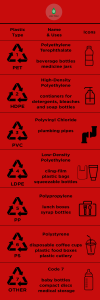PlasticWala: Different Types of Plastic
Before we can effectively and collectively curb the menace of plastic use, it is important to understand the complexity of plastics we are all using! The first step in this process is to identify the type of plastic and understand whether or not it is safe for use!
Moreover, if the plastic you are buying is not labelled, it is best to avoid it!
Now that we know the different types of plastics and their common uses, it is imperative to understand the difference between them and the ones that are safer to use!
PET (Beverage bottles) – It is one of the most downcycled plastic to make products of lower qualities. Due to shorter life of PET products, most of it ends up in landfills. Studies show it releases carcinogens in the food or liquids stored in. We recommend to AVOID PET.
HDPE (Soap Bottles) – It is also a commonly downcycled plastic and also sometimes recycled. It is also comparatively a stable material and safer for food and drinks. We recommend HDPE to be RELATIVELY SAFE!
PVC (Plumbing pipes) – It is considered to be one of the most toxic plastic and very low recycling takes place. Most commonly used for plumbing houses, it can be dangerous for health of manufacturers as well as tenants of the house. We recommend to AVOID it.
LDPE (Cling film) – Though it is difficult to recycle, it is comparatively a stable material. It can be mildly toxic when exposed to sunlight. We recommend it to be RELATIVELY SAFE.
PP (Hard lunch boxes) – It is difficult to recycle. It is considered comparatively safer plastic for food and drinks. We recommend it to be RELATIVELY SAFE.
PS (disposable coffee cups, plastic cutlery) – Chemicals used in this plastic are carcinogenic and toxic to nervous system. It also has very low rate of recycling. We recommend to AVOID it.
Code 7 (Baby bottles, CDs) – Others is the plastic which contains multiple chemicals and do not fall in either of the above discussed plastics. Due to complexity of the material, it is difficult to recycle and has very low recycling rate. It also has chemicals which lead to endocrine dysfunction, carcinogens and other health disorders. We recommend to AVOID it.
Why are plastics unsafe?
We have been using plastic in all our products without knowing about its implications on human health. Certain chemicals migrate into the food during the manufacturing and packaging process involving plastic.
There are many example of plastic contaminating food including Styrene from polystyrene, plasticizers from PVC, antioxidants from polyethylene and acetaldehyde from PET. These chemicals are either toxic and carcinogenic or result in endocrine disruption leading to health disorders.
Plastic breaks into smaller particles but does not degrade easily. These smaller particles are called microplastics. These smaller plastics remain in the environment and are consumed by animals and enter food chain.
There are reports suggesting that microplastics may also be present in bottled water. Although the effects of microplastics on human health are unknown, they keep accumulating in our bodies over time. For smaller animals and birds, it can be fatal as they block the digestive systems!
What does recycling plastic actually mean?
Recycling is a process of converting our waste into other products. What we don’t know is that it can be done in three ways: upcycling, recycling and downcycling.
Upcycling means a creative use of the waste to get a product of better quality with more environmental and economic value. A recycled product is produced when it can be reused as the same product after some process. Downcycling waste gives a product of lower quality than the original and ultimately it gets biodegraded.
Many artists and creative thinkers have shown ways to upcycle plastic but it is not a scalable alternative with the quantum of waste we generate.
When we think we recycle plastic, it is not being recycled but downcycled. This means that the plastic is reduced to a lower quality plastic. After one cycle of whatever little plastic is “recycled”, it eventually ends up in the waste cycle since its properties do not allow it to biodegrade.
As consumers, we are often unaware of these complexities and they only increase when we dig in deeper.
Ways to curb usage of some types of plastic and alternatives:
If at all you must use a plastic container, transfer the food and beverages to another reusable container to avoid any ill effects.
It is also necessary to know that to enable recycling, the plastic should be free from any food particles. Therefore, the next time you throw away any plastic with the intention of recycling it, do not forget to clean and dry it thoroughly before doing so.
Written by Allen Francis and Mohit Arora
Illustration by Mohit Arora





